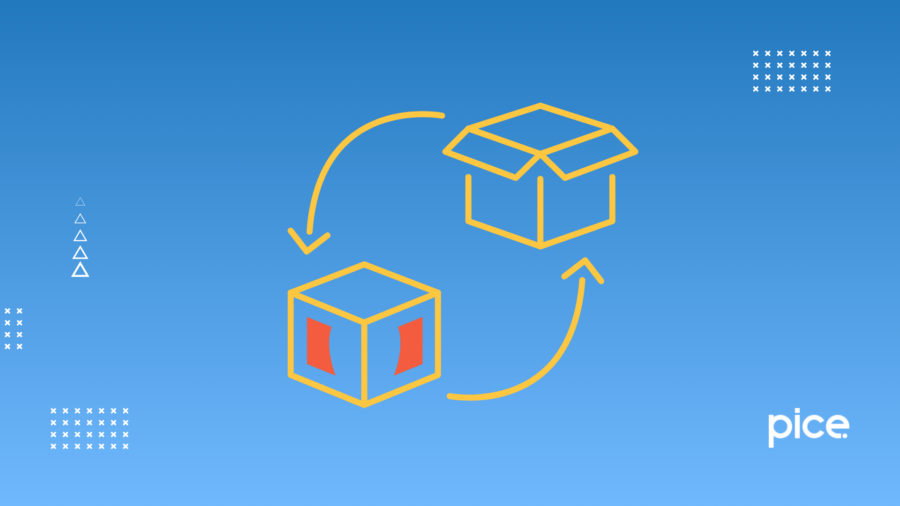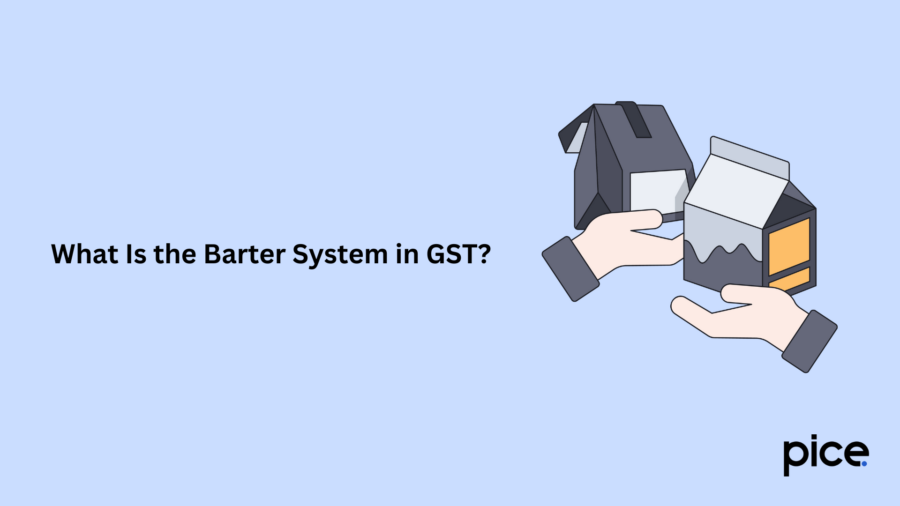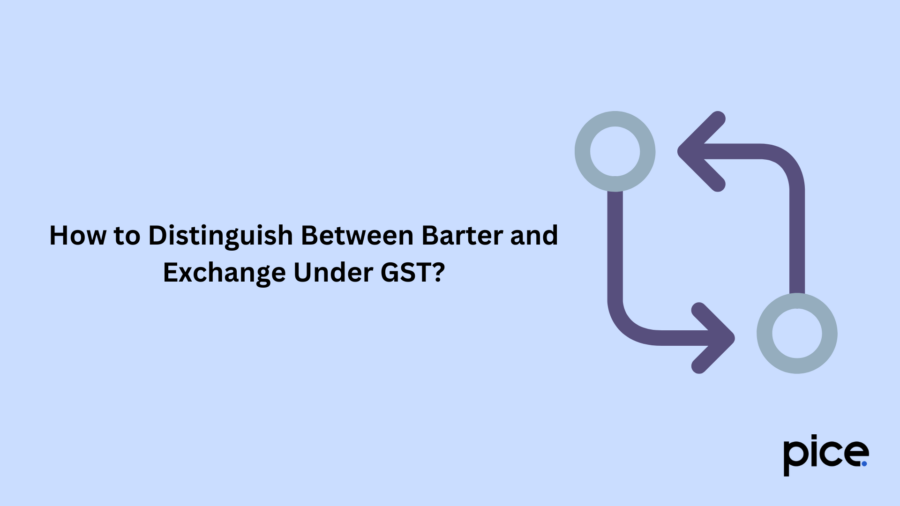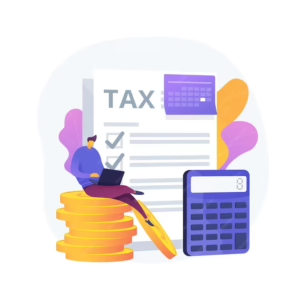Taxability of Barter and GST on Exchange of Goods
- 20 Feb 25
- 8 mins

Taxability of Barter and GST on Exchange of Goods
Key Takeaways
- Barter vs. Exchange – Both qualify as "supply" under GST, but barter involves no cash, while exchange may include partial cash settlement.
- GST Applicability – Barter is taxable under Section 7 of the CGST Act, requiring valuation under Rule 27.
- Consideration in Barter – Goods/services exchanged are considered "consideration" under GST, even without money.
- Valuation Method – Open market value or equivalent price is used for taxation.
- Legal Clarifications – Courts have ruled on barter cases, confirming GST applicability based on transaction details.
GST was introduced to simplify indirect taxation in India. It sought to simplify the process and unify the fragmented and complex taxation system.
Yet, many questions still arise about how it works and in which cases GST is applicable and in which cases it is not. One such question is GST on exchange of goods. There are several questions, such as when such an exchange is treated as a barter or exchange and how such transactions are taxed. In this blog, we will discuss all these issues in detail.
What Is the Barter System in GST?

The Central Goods and Services (CGST) Act, 2017, has not defined ‘barter’. Therefore, to understand this concept, we will look at its conventional meaning.
Barter is a transaction where all parties involved exchange goods or services to get goods or services in return. What distinguishes it is that no money is exchanged in the process. For example, a mechanic may repair the generator of a farmer and in turn, get paid with vegetables cultivated by the farmer.
Thus, at the time of supply, goods are exchanged without the use of any money. Similarly, a joint development agreement also qualifies as a barter.
Bartering is associated with ancient commerce when the concept of money was poorly developed. However, even today such transactions do take place. Moreover, the internet has opened up new avenues for bartering goods or services. In such a transaction, price is not the sole consideration.
What Is Exchange in GST?
Just like barter, ‘exchange’ also remains undefined in the CGST Act. We will look at how a typical dictionary defines it.
At the time of supply, it is an exchange of goods or services between 2 parties. The difference between the value of goods or services is settled in cash or money’s worth. For example, if you want to buy a laptop worth ₹30,000 and you want to exchange a used laptop for ₹7,000, then the actual amount you will have to pay is ₹23,000.
Under GST, such a transaction will be treated as a supply only when it follows Section 7 of the CGST Act. For GST on exchange of goods to be applicable, the transaction must have taken place in the ordinary course of business.
How Is GST Applied to Barter?
Barter is considered as one of the forms of supply as per Section 7 of the CGST Act. Thus, it is a taxable supply and GST on the exchange of goods is applicable. But how is tax charged on barter?
As per Section 9 of the Act, a supply is a taxable event. Suppose two people barter their goods with each other. Then both the persons are creating supplies which are separately taxable. For both goods, the correct HSN has to be determined and then the tax has to be applied. Depending on the place of supply, either CGST combined with SGST will be applied or IGST will be applied.
The two parties have to report their transaction individually through the GSTR-1/3B. The transaction will be scrutinised to check if it qualifies as a part of the business. No GST is applicable if a transaction was not carried out as a part of a business.
At this stage, it must be noted that valuation will not be carried out as per Section 15(1) of the Act. That’s because Section 15(1) has 2 conditions which must be satisfied for it to be applicable:
- Price must be the sole consideration in the transaction.
- The parties are not related.
In barter, the 1st condition is not satisfied. That’s because in barter money is not exchanged, instead goods and services are. Since the conditions for Section 15(1) are not satisfied, Rule 27 of the CGST Rules is used for carrying out the valuation.
As per Rule 27, the open market value of the good or service, or the market value of an equivalent good or service is used to find out the valuation. Here, it is important to remark that it can be difficult to find out the value of similar goods or services. It can lead to a lot of litigation and exhaust both the exchequer and the taxpayer.
What Qualifies as Consideration in a Barter Transaction?
As per Section 7 of the CGST Act, for a transaction to be considered a supply, it must be done for consideration. In a barter framework, 2 independent supplies take place without any exchange of money. The question is, will such a transaction qualify as a supply?
To answer this question, you actually need to ask a more fundamental question: What is a consideration?
As per Section 2(31) of the CGST, the following qualify as consideration with regard to the supply of goods or services:
- A payment made over the course of the supply of goods or services or both by the recipient or any other person, but not including any government subsidy. Such a payment can be made in money or otherwise (Emphasis added).
- The monetary value of any act done by a recipient or any other person during the supply of goods or services or both. It must not include any government subsidy.
The provision mentioned above makes it clear that money is not the only kind of consideration under the Act. In a barter transaction, the goods or services exchanged are themselves considered as consideration.
How to Distinguish Between Barter and Exchange Under GST?

If we read Section 7 of the CGST Act, 2017, we can understand that both barter and exchange qualify as supply. However, we have also discussed that these terms are not defined under the Act.
So, if we want to distinguish between both, we need to look at other laws and judicial cases.
Under Section 118 of the Transfer of Property Act, 1882, if 2 people exchange the ownership of 2 things with each other, and none of those things are money, then such a transaction is regarded as an “exchange”.
Thus, barter is an exchange where no value is fixed to the goods or services that are exchanged. However, an exchange is a form of barter where a certain value is fixed to the goods or services exchanged.
In CIT v. Motors and General Stores (P) Ltd. [(1967) 66 ITR 692 (SC)], the Supreme Court distinguished between barter and exchange. Here’s what it said,
‘But in exchange, there is a reciprocal transfer of interest in the immovable property, the corresponding transfer of interest in the movable property being denoted by the word 'barter'. "The difference between a sale and an exchange is this, that in the former the price is paid in money, whilst in the latter it is paid in goods by way of barter." (Chitty on Contracts 22nd Edn., Vol. II page 582).’
Conclusion
Typically, it is considered that barter transactions used to happen before currency was invented. However, barter is used even today, for example, in exchange offers, where you can exchange an old product for a new one.
There can often be questions about how GST is applied to a transaction. In such a case, you can go to court to get a binding ruling. For example, in M/s. Durga Projects & Infrastructure Pvt Ltd, the Karnataka HC gave a binding ruling and declared a real estate transaction as barter.
Ultimately, a case-by-case consideration is required to decide the GST on exchange of goods. You can decide how GST will be applied by reading the relevant provisions and applying them to a transaction. Tax rates can vary according to the value of the taxable services. If required, you can also consult a GST specialist.
💡If you want to streamline your payment and make GST payments via credit card, consider using the PICE App. Explore the PICE App today and take your business to new heights.
 By
By 
















